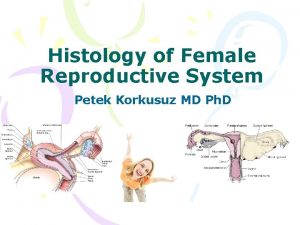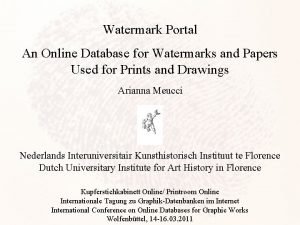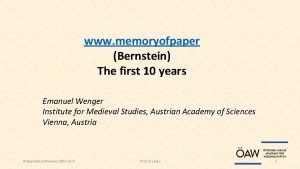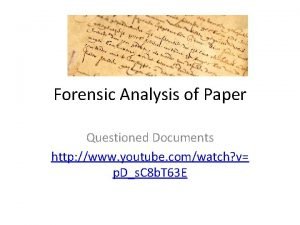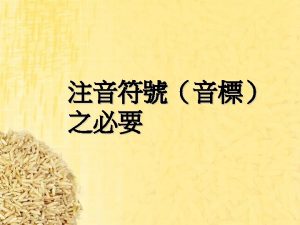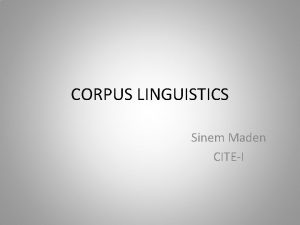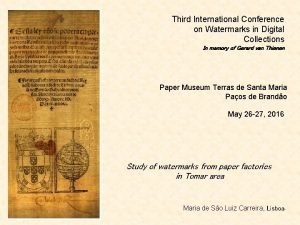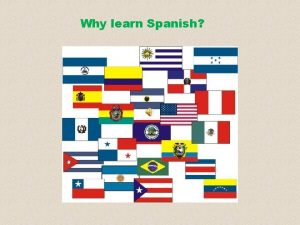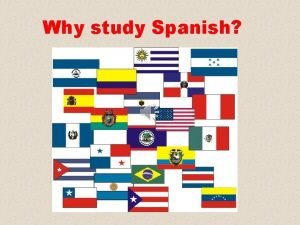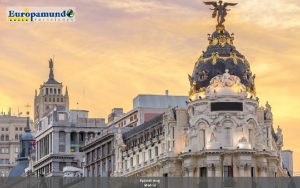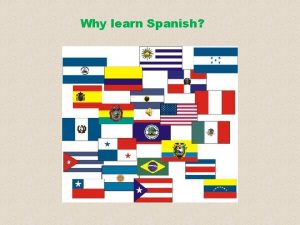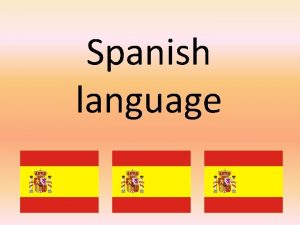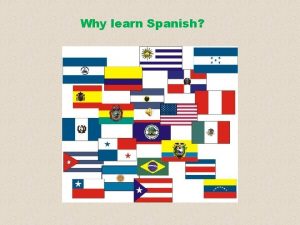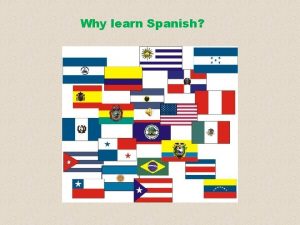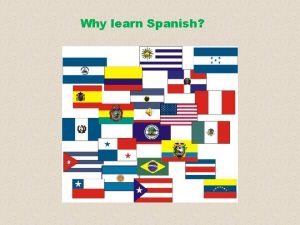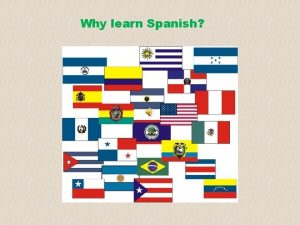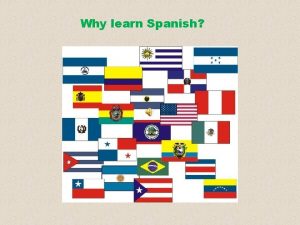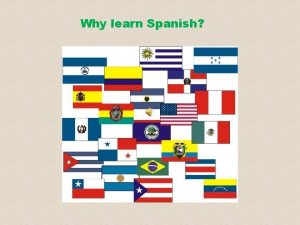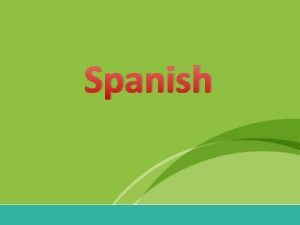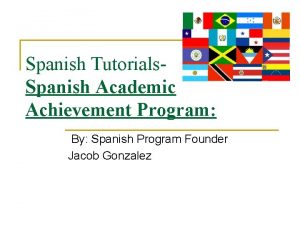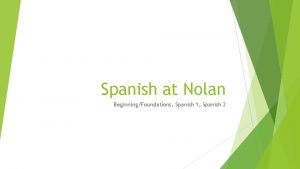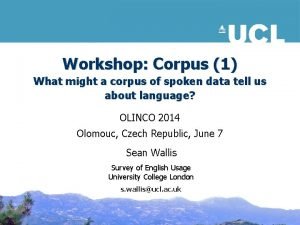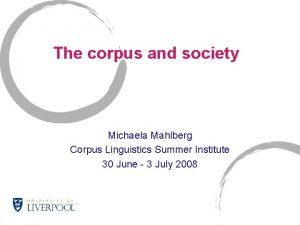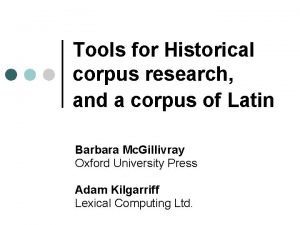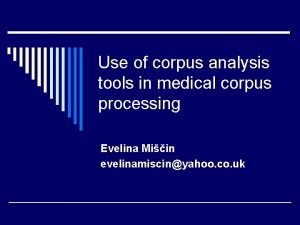The Corpus of Spanish Watermarks 4 th International































- Slides: 31

The Corpus of Spanish Watermarks 4 th International Conference on Watermarks in Digital Collections Vienna, (Austria) 19 y 20 de october de 2017 - Mª del Carmen Hidalgo Brinquis: Director of the project: “Corpus of Spanish Watermarks”. Emeritus of the Spanish Cultural Heritage Institute (IPCE) - Celia Diez Esteban: Curator of the Conservation and Restauration Service of Documental Heritage Bibliographic and Graphic Works. IPCE INSTITUTO DEL PATRIMONIO CULTURAL DE ESPAÑA

Previous Studies: State of the art This project intends to mitigate the delay suffered in the study of the watermarks in Spain, despite being the first European country in which documentary evidence that paper was manufactured in it, (Xátiva, 1154), and be also the one who supplied this material to all Latin-America, thanks to the paper monopoly established by the Spanish Crown.

Unfortunately, Briquet does not collect in this book “Les Filigranes”, watermarks coming from Spanish documentation and we think that this is the starting point for the great ignorance about the Spanish paper.

Despite it, Spain has the honour of possessing a compatriot who is the first author of a book where he has collected several images of watermarks: Carlos Laserna Santander (Santander 1752 Bruselas 1813), published the catalogue of watermarks of incunabula in his uncle’s Library. Later, we have the interesting figure of Manuel Rico y Sinobas (Valladolid 1819 -Madrid 1898), professor of Physics of Madrid University. In addition to his studies in Meteorology he also worked in watermarks, bindings and calligraphy, including to all the matters his knowledge in physics, in a such interesting period in the history of paper as it is the discovery of the continuouspaper.

Contemporary of Briquet, we have Francisco Bofarull y Sans, director of the Archive of the Crown of Aragon, who published: “La Heraldica en la Filigrana del Papel” (1901) and “Animals in Watermarks” (1910). Oriol Valls y Subirá (Barcelona 1915 -1991), following the road opened by Bofarull, he writes “Paper and Watermarks in Catalonia “ in Monumenta Cartae Paperacea vol XII (Amsterdam 1970) and the “History of paper in Spain”, in 3 volumes. Gonzalo Gayoso (Pumares, Asturias 1910 -1996), has written also a history of the paper in Spain, where he mainly studies the Spanish paper during the XVIII and XIX centuries, where a lot of information on remainders of industrial archaeology can be found. In more recent times, the Foundation Barrié de la Maza entrusted José Luis Basanta Campos with the coordination of “Marcas de agua en documentos de los archivos de Galicia”, in 7 volumes.

Preliminary Works This project started in the year 1986 and it gets more importance when it is part of a project I+D of the Commission of Science and Technology, with the title “Paper watermarks creation of a database to the service of Archives, Libraries, Museums and Documentation centers” (IN TF 91 -0151) extended to a Special Action (SEC-94 -1330 -E).

As a result of this initiative, 8. 000 watermarks were joined together, coming from different new collections as: -The Menendez Pidal. From AHN (National Historic Archive) -Fund the Rico y Sinobas collection of the RAE (Royal Spanish Academy) -The private funds of the researcher José Luis Basanta Campos, of the historian José Carlos Balmaceda, as well as collections from Institutions as National Historic Archive and those of the doctoral thesis of Carmen Hidalgo Brinquis. To these first studies were incorporated the watermarks obtained from the workshops of the IPCE in order to be preserved and restored.

To make easier the consult of internal use was created a database by Mª Dolores Diaz Miranda with the help of the computer sciences expert Carlos Garcimartín Ortega. The data were introduced following the IPH instructions, having into account the characteristics of our watermarks. Taking as start-point this database our project and its web page have been created, desiring making accessible this valuable information, via internet, to the researchers interested in these matters.

THE PROJECT The main goal is to convert the Access database into a public consultation one via Internet thus extending the geographical scope to Latin-America. The new application shall: • Allow the load, update and management of data through the web, according to user profiles. • Facilitate consultation data through the web • Provide consultation as complementary elements to glossary and bibliography • Be compatible with Bernstein project.

Technology architecture It is an application-web with following characteristics: • MVC Architecture and JZEE Java technology, an a Apache-Tomcat applications server. • Connection to a database Oracle, with full text extension. • Connection to an image repertory.

Public area The project can be consulted by any researcher obtaining: • Watermarks search: - Search by box text, type Google -Search more specialized by using certain fields • Access to the results: -Data recorded will be displayed, along with one or more associated images. -The tab will be exportable to PDF • Printing Lists: The results searched could be dumped into an Excel

General watermarks search click search

1. - Click watermark number 2. - Click watermark

1. - watermark number

2. - click watermark -Enlarge -Reduce -Detail -Shine -Dark -Turn…

Search by fields

Private area If any researcher desired it, can form part of the project, with these conditions: • Fill in a Formulary. The researcher can enter his data or information. • The data will be checked by the IPCE and the application will be approved. From this moment the introduction of information is possible.

To register the user: we must fill this formulary. Name, surname, country, Institution, mail, password. . .

If the data is approved, click Access and introduce mail and password

The management possibility is great, others windows appears: User management, motifs management, inbox of watermarks information

Consult previous inbox information. We can to register a new watermark. Click sheet code

If we click “sheet” we can to introduce sheet data: researcher, type of paper, type of document, state of sheet, format, number page, origin, measures. . . Click sheet

If we click “watermarks”, we can introduce the data: kind of watermarks, description motif, origin, measures, structure, position, number of “corondeles”, additional information. . . Click Watermark

The application has several windows of general information: -Project: Summary of the project, indicating its objectives -Glossary: Being a glossary with a very specific terminology, we have thought of introducing an innovation in its concept. Pictures of the terms causing confusion are joined. -Help: Clarification of possible doubts about the management of application

-Resources: (with two entries) • Links: The more importants databases existing of watermarks are gathered. • Bibliography: A basic bibliography about the making of paper and Watermarks, mainly published in Spanish, is offered. -Credits: Persons responsible of the project. -Contacts: Persons to contact and ask to form part of the project.

Glossary: We can introduce the terms we needs to know and it offer us all terms related about it.

User manual Collaborator manual Administrator manual Publisher manual

• Presently we approximately have 20. 000 watermarks. The initial collection was completed by adding the funds of Manual Rico y Sinobas, Basanta Campos y Gonzalo Gayoso. • Some of these collection are of the beginning XX century and they are poor in datas but we have included them being some cases the only datum we have. • Finally, it is going to be added the collection of watermarks belonging to the Museu Moli Paparer de Capellades and the collection of José Carlos Balmaceda.

• We consider that we have a great number of watermarks and it´s time to make the official presentation of this Corpus in the Bernstein Project. • Because of it we are organising a meeting at the Ministerio de Educación, Cultura y Deportes, at Madrid in May 2018, to which we wish to invite several representatives of Institutions Spanish and Ibero-American and we would like to count with your presence.

We hope this project to be very useful, not only in dating the documentation recovered in Spanish centers, but also the documentation belonging to the Ibero-American community; in fact, the paper used since the XVI century to the XVIII century is practically the same on both sides of the Atlantic, due to the existence of Monopoly Royal Rights on the commerce of paper overseas, the taxes on sealing paper, and the prohibition to build paper mills in Ibero-America.

Instituto del Patrimonio Cultural de España Ministerio de Educación, Cultura y Deporte. Thank you for your attention carmen. hidalgo. brinquis@gmail. com celia. diez@mecd. es
 Uterus layers histology
Uterus layers histology Follicle stage
Follicle stage Watermark database
Watermark database Emanuel wenger
Emanuel wenger Forensic analysis of paper
Forensic analysis of paper Spanish 1 final exam review packet answer key
Spanish 1 final exam review packet answer key International phonetic alphabet spanish
International phonetic alphabet spanish Một số thể thơ truyền thống
Một số thể thơ truyền thống Trời xanh đây là của chúng ta thể thơ
Trời xanh đây là của chúng ta thể thơ Số nguyên tố là
Số nguyên tố là đặc điểm cơ thể của người tối cổ
đặc điểm cơ thể của người tối cổ Tỉ lệ cơ thể trẻ em
Tỉ lệ cơ thể trẻ em Phối cảnh
Phối cảnh Các châu lục và đại dương trên thế giới
Các châu lục và đại dương trên thế giới Thế nào là hệ số cao nhất
Thế nào là hệ số cao nhất ưu thế lai là gì
ưu thế lai là gì Sơ đồ cơ thể người
Sơ đồ cơ thể người Tư thế ngồi viết
Tư thế ngồi viết Các môn thể thao bắt đầu bằng từ đua
Các môn thể thao bắt đầu bằng từ đua Hình ảnh bộ gõ cơ thể búng tay
Hình ảnh bộ gõ cơ thể búng tay Cái miệng bé xinh thế chỉ nói điều hay thôi
Cái miệng bé xinh thế chỉ nói điều hay thôi Cách giải mật thư tọa độ
Cách giải mật thư tọa độ Tư thế ngồi viết
Tư thế ngồi viết Chó sói
Chó sói Thẻ vin
Thẻ vin Thể thơ truyền thống
Thể thơ truyền thống Các châu lục và đại dương trên thế giới
Các châu lục và đại dương trên thế giới Hổ đẻ mỗi lứa mấy con
Hổ đẻ mỗi lứa mấy con Từ ngữ thể hiện lòng nhân hậu
Từ ngữ thể hiện lòng nhân hậu Diễn thế sinh thái là
Diễn thế sinh thái là Lp html
Lp html Ví dụ về giọng cùng tên
Ví dụ về giọng cùng tên

